Submitted by Tyler Durden on 08/14/2015 20:37 -0400
Every quasi-mushroom cloud has a silver lining. That was our cynical conclusion yesterday when we noticed that as part of China’s tragic Tianjin mega-explosion, thousands of channel-stuffed cars parked at the Chinese port which likely would have quietly rusted away into the epic nothingness of China’s unprecedented excess capacity of pretty much everything, were destroyed, thereby one-time reducing at least some of the gargantuan slack in the Chinese economy.
Which got us thinking: if natural disasters, either accidental or man made, are a tangential blessing to the Chinese economy, why stop at the Tianjin explosion? What about the biggest bogeyman facing China today – its environmental catastrophe, demonstrated best by the impenetrable, carciongenic and toxic smog resulting from the accelerated industrialization of the country, and which the citizens of Beijing, Shanghai, and increasingly more cities, have to breathe in day after day?
It has hardly been a secret that the unprecedented level of pollutants in the Chinese air would impair life expectancy and lead to extensive health problems, but even we were surprised to find out the quantification of China’s air problem: according to one study, an average of 4,000 people a day are killed in China, as a result of the dense smog.
According to Bloomberg, “deaths related to the main pollutant, tiny particles known as PM2.5s that can trigger heart attacks, strokes, lung cancer and asthma, total 1.6 million a year, or 17 percent of China’s mortality level, according to the study by Berkeley Earth, an independent research group funded largely by educational grants. It was published Thursday in the online peer-reviewed journal PLOS One from the Public Library of Science.”
“When I was last in Beijing, pollution was at the hazardous level: Every hour of exposure reduced my life expectancy by 20 minutes,” Richard Muller, scientific director of Berkeley Earth and a co-author of the paper, said in an e-mail. “It’s as if every man, woman and child smoked 1.5 cigarettes each hour.”
To be sure, Chinese authorities have acknowledged the air pollution situation after heavy smog enveloped swathes of the nation including Beijing and Shanghai in recent years. As a result, they’ve adopted air quality standards, introduced monitoring stations and cleaner standards for transportation fuel while shutting coal plants and moving factories out of cities. So far, however, all the proactive measures seem to have little result.
“The PM2.5 concentrations far exceed standards, endangering people’s health, though air quality has improved in the first half in the 358 Chinese cities,” said Dong Liansai, climate and energy campaigner at Greenpeace East Asia.
As Bloomberg further reports, Muller and co-author Robert Rohde analyzed four months of hourly data for some 1,500 ground stations in China. They then employed a model used by the World Health Organization to calculate the disease burden.
They found that 92 percent of China’s population experienced at least 120 hours of unhealthy air during the April 5, 2014, to Aug. 5, 2015 study period. For 38 percent of the population, the average pollution level across the entire four-month period was deemed unhealthy.
Here one may wonder whether the US DOE funded Berkley researchers were pursuing some specific, anti-coal agenda, as confirmed by the following assessment:
“the Berkeley Earth researchers also examined where the pollutants were detected and concluded that the sources of PM2.5s matching those for sulfur dioxide suggests most of the pollution comes from burning coal.
“Sources of pollution are widespread but are particularly intense in a northeast corridor that extends from near Shanghai to north of Beijing,” the researchers wrote. “Extensive pollution is not surprising since particulate matter can remain airborne for days to weeks and travel thousands of kilometers.”
China gets about 64 percent of its primary energy from coal, according to National Energy Administration data. It’s closing the dirtiest plants while still planning new, cleaner ones. The country is expected to shut 60 gigawatts of plants from 2016 to 2020 though three times as many plants are scheduled to be built using newer technology, according to Sophie Lu, a Bloomberg New Energy finance analyst in Beijing.
To cut reliance on coal, the nation also wants to derive 20 percent of its energy from renewables and nuclear by 2030, almost double the current share.
But whether it is due to coal or not, is irrelevant: the truth is that China does have a problem with preserving its environment and keeping the quality of its air. Some examples shown previously:

Pollution from a factory in Yutian, 100km east of Beijing

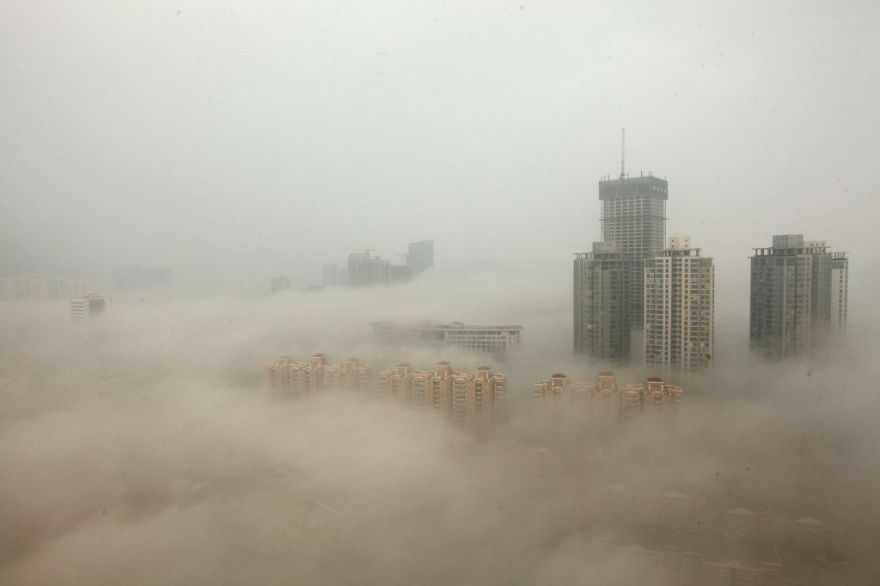

Smog In Beijing
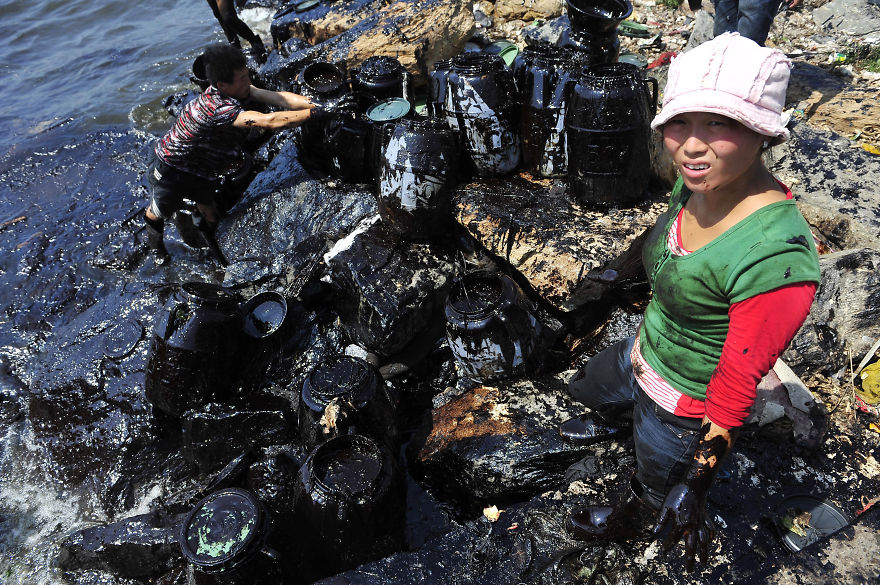
Fishermen clean up oil at an oil spill site near Dalian Port, Liaoning province
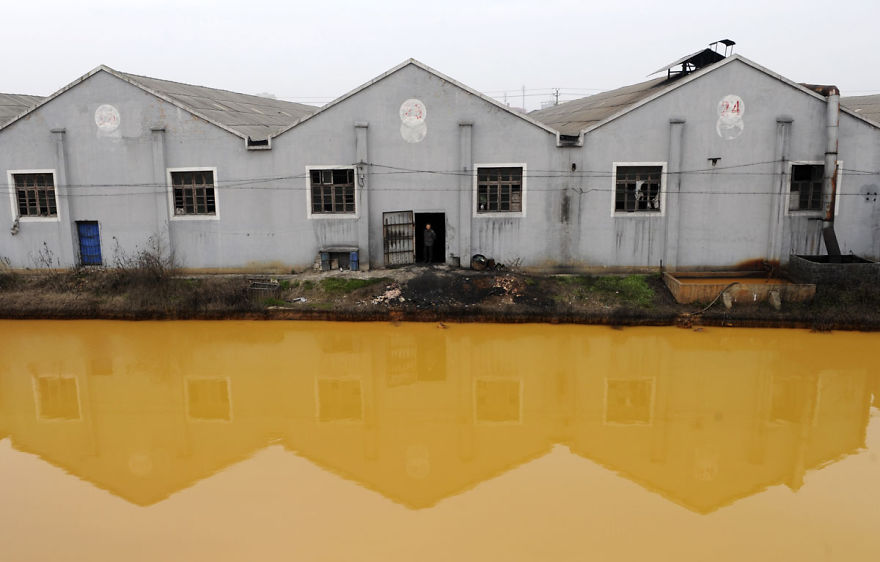
Heavily Polluted River In Jiaxing, Zhejiang
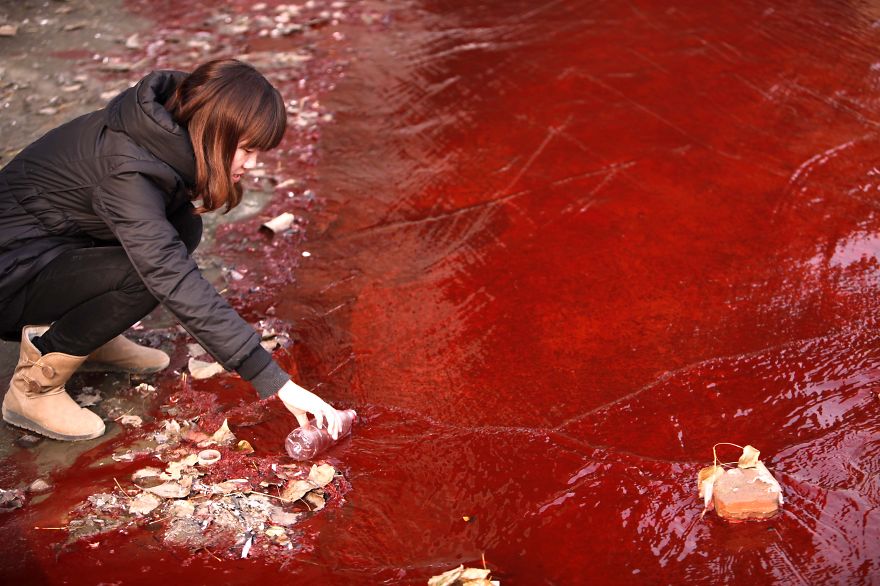
Journalist takes a sample of red polluted water in the Jianhe River in Luoyang
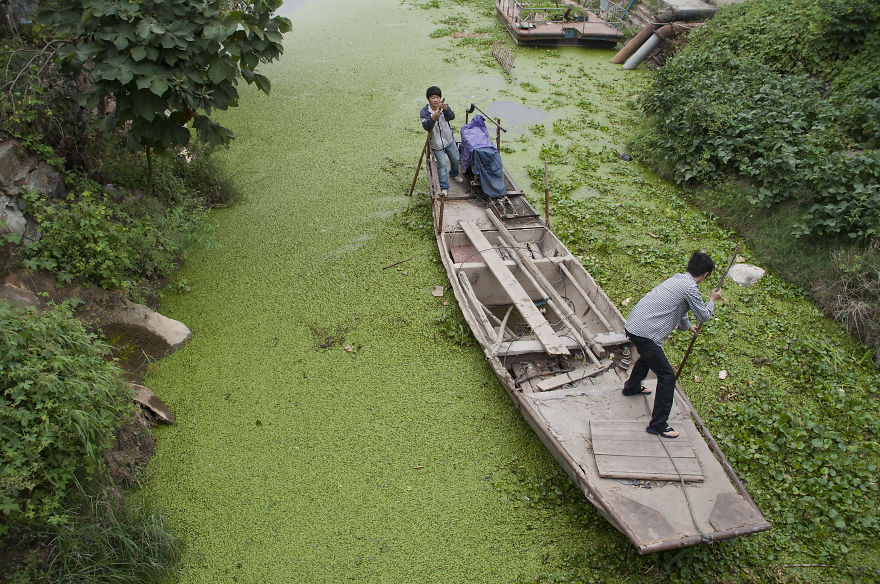
Heavily Polluted River
* * *
Which got us thinking: if the Tianjin explosion unclogged the car channel stuffing problem, if only for a few days, then perhaps China pollution serves a different, more ulterior purpose.
Recall that the US social security trust fund is going broke faster by the day since Americans refuse to die at the age they were expected to die when social security was first conceived 80 years ago. As a result, because of progress one of the biggest entitlement systems in the US is on the verga of default.
When it comes to pension and retirement benefits, the US, with its 330 million people, is nothing compared to China with its 1.2 billion and rising. So what is the best way to “resolve” this problem? Perhaps by introducing an external agent, one that culls the population at a pace of 4000 (and rising rapidly) per day.
Because while the number of deaths resulting from China’s smog is astounding, something else very surprising is how little progress has been achieved in the battle to clean up China’s air in the past several years, especially since any long-lasting clean up would also lead to a permanent reduction in the industrial output of China’s manufacturing heartland and lead to, drumroll, a violent drop in GDP, a drop which as the current episode demonstrates, would lead to a collapse in the Chinese stock market, an even greater pop in the housing and credit bubble, and far more violent devaluation of the local currency with the attendant negative global economic impact. Not to mention lead to an extension in the longevity of China’s population, which the local actuaries have just one word for: crisis.
Which is why despite all the rhetoric, and all the “reform” don’t expect China’s pollution problem to get better. In fact, expect it to deteriorate substantially because in the immortal words of that other famous communist, “When there’s a person, there’s a problem. When there’s no person, there’s no problem” and China’s pollution is taking care of 4000 problem each and every day…







Muller and Robert Rohde are environmental activists, typically resorting to extreme exhortations of catastrophe, doom and gloom. The Eco-Nazi’s in full bloom.
I don’t disregard environmental concerns, but I am able to discern reality vs hyperbole.
Soooo….looks like the worst pollutors and carbon emitters are not the Evil Capitalistic White People after all……
Several years ago, back when RE was doing his “China is toast” routine …. I would agree with him primarily because of how they are polluting their country in every conceivable way …… and most folks minimized that or flat out disagreed. So, it’s refreshing to see that some bigger news outlets are coming around. China IS toast. Just a matter of a little more time, much like ‘Murika.
Somebody will have to pay money out for that destruction and death; that won’t be good for them and might become a Lehman Brothers event for Chinese or whoever in finance, insurance etc. To bad it wasn’t ISIS, Iran or North Korea but I’m sure they are working on some big accident for US.
I think most of the population of the world is toast if the owners have they way.
The Great China Ponzi—-An Economic And Financial Trainwreck Which Will Rattle The World
By David Stockman
David Stockman’s Contra Corner
August 15, 2015
There is an economic and financial trainwreck rumbling through the world economy. Namely, the Great China Ponzi. In all of economic history there has never been anything like it. It is only a matter of time before it ends in a spectacular collapse, leaving the global financial bubble of the last two decades in shambles.
But here’s the Wall Street meme that is stupendously wrong and that engenders blind complacency with respect to the impending upheaval. To wit, the same folks who brought you the myth of the BRICs miracle would now have you believe that China is undergoing a difficult but doable transition——-from an economy driven by booming exports and monumental fixed asset investment to one based on steady as she goes US-style consumption and services.
There may well be some bumps and grinds along the way, we are cautioned, such as the recent stock market and currency turmoil. But do not be troubled—–the great locomotive of the world economy will come out the other side better and stronger. That’s because the wise, pragmatic and powerful leaders and economic managers who deftly guide China’s version of capitalism have the capacity to make it all happen.
No they don’t!
China is not a clone-in-the-making of America’s $18 trillion consume till you drop economy—-even if that model were stable and sustainable, which it is not. China is actually sui generis—–a historical freak accident that has no destination other than a crash landing.
It’s leaders are neither wise nor deft economic managers. In fact, they are a bunch of communist party political hacks who have an iron grip on state power because China is a crude dictatorship. But their grasp of the fundamentals of economic law and sound finance can not even be described as negligible; it’s non-existent.
Indeed, their reputation for savvy and successful economic management is an unadulterated Wall Street myth. The truth is, the 25 year growth boom in China is just a giant, credit-driven Ponzi. Any fool can run a central bank printing press until it glows white hot.
At the end of the day, that’s all the Beijing suzerains of red capitalism have actually done. They have not created any of the rudiments of viable capitalism. There are no honest financial markets, no genuinely solvent banks, no market driven allocation of capital and no financial discipline which comes from the right to fail as well as succeed.
There are, for instance, 287 million equity trading accounts in China, most of them opened within the last year and overwhelmingly held by retail punters with sub-high school educations. In less than 12 months they took down upwards of $1 trillion of margin debt through official brokerage channels and a massive network of shadow banking sources including dodgy peer-to-peer lending arrangements.
So fortified, they clambered after a stock market bubble that expanded by $3 trillion in just 60 trading days ending on June 14, and then broke into a panicked selling stampede that liquidated that very same $3 trillion of bottled air in hardly 20 trading days thereafter.
Then the state sent out the paddy wagons to arrest and intimidate the panicked sellers and threw-open the central bank’s credit lines to fund hundreds of billions of unwanted stocks. That is not capitalism, red or otherwise; it’s desperate, mindless madness.
Likewise, there are no credible institutions of contract law and bankruptcy. There is not even minimally honest corporate financial reporting and no restraints at all on the propensity of China’s newly affluent masses to gamble in real estate, stocks, commodity financing schemes, dodgy private lending clubs, chain letters and endless similar get rich quick schemes.
Most importantly, there are no lines of demarcation between the property of the state and the license of officialdom and their cronies to expropriate it. In a word, China wallows in the greatest cesspool of corruption known to history because that’s what happens when you erect a $10 trillion command economy virtually over night.
And the swaying edifice of red capitalism has indeed been stood up overnight. At the time that Mr. Deng radically changed the party line——proclaiming that it is glorious to be rich and the PBOC slashed the RMB exchange rate by 60% in 1994 in order to jump start an export boom——there was less than one half trillion dollars of credit market debt outstanding. Alas, that figure today is $28 trillion according the cautious reckoning of McKenzie, and most likely far more.
Here’s the thing. You can not safely, sanely or efficiently grow by 56X in hardly two decades something as combustible as cheap, come-and-get it state supplied credit in an environment where the rudiments of market capitalism do not even exist. If you pursue that kind of financial Frankenstein, that’s exactly what you will get, and that’s what the comrades in Beijing actually got.
Now, however, the iron law of financial bubbles has caught up with them. That is, when you stop supplying increasingly massive amounts of new credit to what eventually becomes an elephantine bubble, it begins to fall inward.
This happens slowly at first, then with accelerating momentum, and finally culminates in a panic-riven meltdown. That sequence encapsulates the entirety of the 2006-2008 securitized mortgage meltdown on Wall Street, the late 1980s and early 1990s Tokyo real estate boom and bust, the 1979-1980 silver and gold bubbles and countless others stretching back centuries in time.
So the passive-aggressive posture of China’s officialdom about what even they recognize as the out-of-control credit bubbles in their realm has no rhyme or reason. Beijing’s recent hoping from one foot to the other, first stimulating and then braking, is rooted in pure desperation and seat of the pants adhockery.
Wall Street sees none of this, however, and for a reason dripping with irony. Namely, since the ascension of Alan Greenspan to the Fed in 1987, the epicenter of world capitalism——that is, the money and capital markets of Wall Street—-has fallen prey to a regime of monetary central planning. Price discovery in the financial auction markets has been supplanted by price administration decreed by the twelve mortals who comprise the FOMC. A monetary politburo, if you will.
Not only has this increasingly heavy-handed central bank intrusion falsified financial asset prices, subsidized rampant carry trade speculation, eliminated an honest risk-reward calculus and destroyed short sellers and other natural instrumentalities of financial discipline, but it has also drastically changed the culture of the financial markets.
The overwhelming share of players in what has become a central bank enabled casino are now de facto statists. They believe that the agencies of the state can and should peg money market interest rates, prop up the bond market via massive monetization of the public debt, and eliminate “contagion” outbreaks in the equity and other risk asset markets.
Except “contagion” is a red herring. Its just another name for old-fashioned market breaks and bear raids on speculative excesses and reckless leveraged gambling. This kind of bear market liquidation is essential for healthy capital and money markets, but its been extinguished by the Greenspan/Bernanke/Yellen “put” and the casino’s overwhelming conviction that the central bank will flood the market with liquidity should another Lehman-style meltdown ever manage to incept.
All of this adds up to the conviction that governments drive the process of economic growth and wealth creation and that capitalism thrives best when it is nourished and guided by the helping hand of the state, most especially its central banking branch.
Needless to say, that self-serving but misbegotten ideology would never have taking root in Wall Street 50 years ago. In the days when the great William McChesney Martin took away the “punch bowl” just six months after the 1957-1958 recession ended by a series of stiff interest rate increases and by raising stock margin requirements to 90% of market value, the captains of finance would never have dreamed of 80 straight months of zero money market rates, as has now occurred.
They would have been screaming to high heaven that such radically unsound finance was a mortal danger to the nation’s wealth. By contrast, today they think they are entitled to central bank “accommodation” for as long as might be necessary to keep the stock averages rising. So while 80 months of ZIRP is nothing less than a recipe for massive speculation that will inexorably lead to a resounding bust they don’t even notice the danger.
Worse, the Wall Street casino inhabitants have no clue that while bubble finance is dangerous enough in a relatively mature capitalist economy like that of the US, it is pure monetary nitroglycerin in a setting like the China credit Ponzi.
Nor do they have the slightest inkling that PBOC head, Zhou Xiaochuan, is not just an Asian version of Janet Yellen who wears trousers and dyes his hair black.
Stated differently, Wall Street cannot see straight when it comes to China because its crypto-Keynesian lenses lead it to suppose Mr. Zhou will stump up whatever liquidity and bailouts may be necessary and that his colleagues in Beijing will open the fiscal stimulus spigots if growth continues to falter.
Well, Mr. Zhou may talk the idiom of central banking, but he’s just a servant of the communist overlords whose overwhelming purpose is to stay in power and whose colossal economic and financial ignorance will lead them to destructive expedients that will make the paddy wagon brigades now combing the brokerage houses look mild by comparison.
Its too late for a soft landing and managed deflation of the Great China Ponzi. But in their desperation to forestall the inevitable crash, the suzerains of red capitalism will increasingly turn to the mailed fist of state repression.
Indeed, the can’t any longer rely on the proposition that party power comes from the end of Mr. Deng’s printing press. To do so will only exacerbate the massive capital flight that is already underway and which threatens a devastating further plunge of the RMB exchange rate.
The latter is the Achilles Heel of the whole Ponzi. To arrest capital flight they will have to do the opposite of what they have done for the last 20 years. That is, they will have to shrink the domestic money supply and banking system in order to sell dollars and euros rather expand domestic credit in order to sequester dollar liabilities (i.e. treasury bonds) in the PBOC.
In due course, China will be aflame with campaigns against corruption and enemies of the state as it seeks to cope with its collapsing financial bubbles and endless herds of economic white elephants. Chairman Mao’s axiom as to where state power really comes from——that is, the barrel of a gun—-will become the increasingly evident modus operandi of the communist party rulers.
The resulting deflationary spiral will suck the global economy into its vortex. And Wall Street will go down for the count because this time the Fed will be utterly powerless to reverse the tide.
I always laugh at the idea of moving from the quite countryside to a smog filled city as improving your life. I keep reading that China push’s this idea. The concept of things making your life better. China never was a place big on God.
@Hope, Yes but we and the Brits have been spewing shit into the atmosphere since the Industrial Revolution. I’ll betcha air in NYC or Detroit back in the 20’s & 30’s was just as polluted. Even in the early 60’s I can remember driving through the West end of Louisville and the air would be thick with all kinds of chemical smells from Rubbertown and Dow chemical. There was even a refinery just blocks from housing. When we moved there in 1962 I immediately started having severe sinus problems; got better when we moved back to Sou Indiana in 1966.